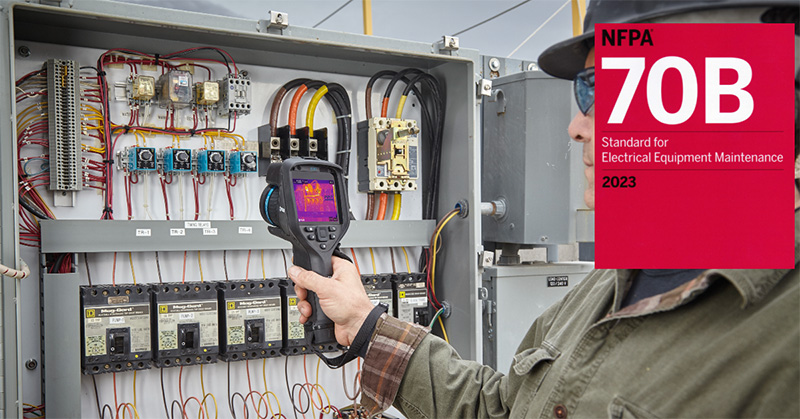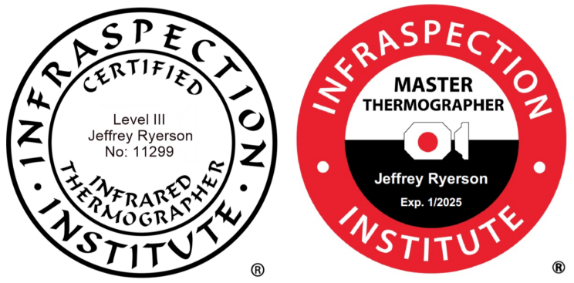What are the Reporting Requirements for Thermography According to NFPA 70B 2023?

Thermography is a powerful technique for detecting and measuring infrared energy emitted by electrical equipment. It can help identify potential problems such as overheating, loose connections, faulty insulation, and other defects that can lead to failures, fires, or injuries. However, thermography is not just about taking pictures of hot spots. It also requires proper documentation, analysis, and reporting of the inspection findings.
The National Fire Protection Association (NFPA) has recently updated its guidelines for creating an effective electrical preventive maintenance (EPM) program in the NFPA 70B 2023 edition. The NFPA 70B is a widely used reference for industrial plants, commercial buildings, and large residential complexes that need to maintain their electrical systems in a safe and reliable condition. The NFPA 70B 2023 edition has made some significant changes regarding the use of thermography as part of the EPM program, especially in terms of reporting requirements.
According to the NFPA 70B 2023, thermography shall be used to measure the temperature difference (Delta T or ΔT) of similar electrical components under similar loading, and to compare the temperature differences between electrical components and ambient air temperature (Section 7.4.1). Delta T is a key indicator of potential issues within electrical equipment, as it can reveal abnormal heating caused by various factors such as high resistance, overloading, harmonics, corrosion, or deterioration.
The NFPA 70B 2023 also states that "temperature differences between the area of concern and the reference area shall be documented" (Section 7.4.3). This means that thermographers need to record the ΔT values for each component or area that shows a significant deviation from the norm or from the previous inspection. The documentation should also include additional information to stay compliant with other published standards. The report should include information such as:
- The date and time of the inspection
- The name and qualification of the thermographer
- The type and model of the thermography equipment used
- The emissivity and reflected temperature settings used
- The ambient temperature and humidity conditions
- The circuit loading characteristics and operating conditions
- The location and identification of the equipment inspected
- The thermal images and visible images of the equipment inspected
- The ΔT values for each area of concern and reference area
- The severity level and recommended action for each area of concern
The documentation should be clear, concise, and consistent, using standardized terminology and formats. It should also be retained for future reference and comparison, as it can help track the changes in condition over time and evaluate the effectiveness of the EPM program. Examples of how to construct a report can be found in Annex E of the NFPA 70B 2023.
The NFPA 70B 2023 also provides guidance on how often thermography inspections should be performed, depending on the physical condition of the equipment. The NFPA 70B 2023 defines four levels of equipment physical condition, from Condition 1 (new or like new) to Condition 4 (unacceptable risk). For thermography inspections, the NFPA 70B 2023 recommends the following frequencies:
- Equipment Physical Condition 1 shall be assigned where all the following criteria apply:
- Condition 1 (Section 9.3.3.1): At least once every 12 months
- The equipment appears in like new condition
- The enclosure is clean, free from moisture intrusion, and tight
- No unaddressed notification from the continuous monitoring system has occurred There are no active recommendations from predictive techniques
- Previous maintenance has been performed in accordance with the EMP
- Equipment Physical Condition 2 shall be assigned where all the 9.3.3.1 apply and where any of the following criteria apply:
- Condition 2 (Section 9.3.1.2): At least once every 12 months
- Maintenance results deviate from past results or have indicated more frequent maintenance in accordance with manufacturer’s published data
- The previous maintenance cycle has revealed issues requiring the repair or replacement of major equipment components
- There have been notifications from the continuous monitoring system since the prior assessment
- There are active recommendations from predictive techniques
- Equipment Physical Condition 3 shall be assigned where changes in operation are noted or where any of the following criteria applies:
- Condition 3 (Section 9.3.1.2): At least once every 6 months
- The equipment has missed the last two successive maintenance cycles in accordance with the EPM
- The previous two maintenance cycles have revealed issues requiring the repair or replacement of major equipment components
- There is an active or unaddressed notification from the continuous monitoring system There are urgent actions identified from predictive techniques
- Condition 4 Nonserviceable Equipment (Section 9.3.1.4): Immediate Action
- Equipment that poses an imminent risk of injury or negative health effects to personnel shall be designated as nonserviceable in accordance with Section 8.7.1.3
By following these reporting requirements for thermography according to NFPA 70B 2023, thermographers can ensure that they provide accurate, reliable, and useful information to their clients or employers, as well as comply with the industry standards and best practices. Thermography is not only a valuable tool for detecting problems, but also for documenting them and communicating them effectively.
If you are looking for a reliable and professional company that can provide you with comprehensive infrared thermography inspection services for any application or industry,
Look Thermography Corp. is the one you need.
Contact us today at (561) 309-9057 or visit our website at https://www.lookthermography.com/ to learn more about our services or request a quote.

Advertisement

